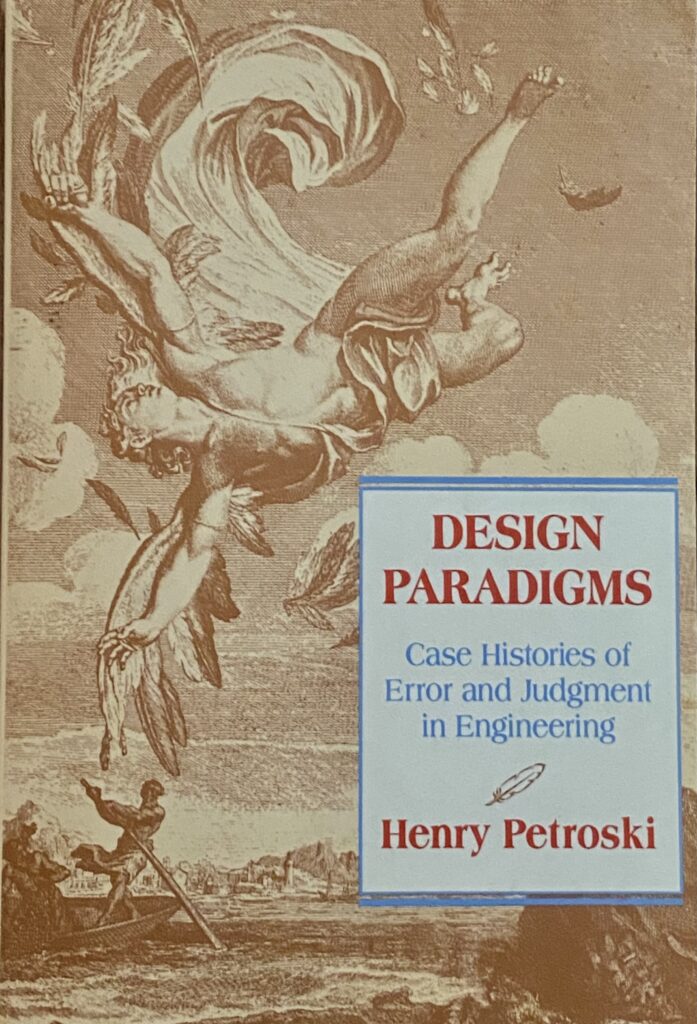
This is part 2 of my assessment of “Design Paradigms: Case Histories of Error and Judgment in Engineering”. It was written by Henry Petroski who teaches at Duke University.
Paraphrasing from Petroski, “The first and most indispensable engineering design tool is judgment. Engineering judgment get projects started in the right direction and keeps a critical eye on their progress. Engineering judgment is what from the very beginning of a conceptual design identifies the key elements that go to make up an analytical or experimental model for exploration and development. It’s judgment that separates the significant from the insignificant details, and it is judgment that catches analyses that are going astray. Engineering judgment is the quality factor among those countless quantities that have come to dominate design in our computer age. Judgment tells the designer what to check on the back of an envelope and what to measure at the construction site. Judgment, in short, is what we can use to avoid mistakes, what catches errors, what detects flaws and what anticipates and prevents failure. The single most important source of judgment lies in learning from one’s mistakes and those of others”. That may be the most important passage in the entire book.
Petroski wrote that the “single most fruitful source of lessons in engineering judgment exists in the case histories of failures, which point incontrovertibly to examples of bad judgment and therefore provide guideposts for negotiating around the pitfalls around the design process itself. Another valuable lesson in sound engineering judgment comes from the great engineers, who by their work have demonstrated that they possessed impeccable judgment, which has more often than not come from their critical study of failures and near-failures”. Petroski wrote that “in case after case the proper anticipation of failure has always been the mark of the most successful engineers, and that lack of judgment is what leads to failures”. Petroski continued that “ignoring wholesale the lessons and practices of the past threatens the continuity of engineering and design judgment that appears to be among the surest safeguards against recurrent failures”.
Petroski states that “the absence of failure does not prove that a design is flawless, for a latent failure mode may be triggered by yet-unexperienced conditions. However, it appears to be a trait of human nature to take repeated success as confirmation that everything is being done correctly. In such a design climate each successive success reinforces the view and drives the state of the art further from considering fundamental failure criteria as the true principles upon which designs must be based. The absence of dramatic failures can only make designers complacent with regard to the genre of which they are do justifiably proud; a climate of success can also make designers react more slowly to warning signs that something is wrong”.
Speaking of bridge failures, Petroski wrote that “each bridge that failed either represented an evolutionary increment in a long line of similar bridges that had performed satisfactorily, or represented a step taken with the assurance that it was being done with an adequate factor of safety or with a sound foundation in theory”. Ultimately, the designers of those failed bridges did not foresee the actual cause of failure. Petroski continued, “since human error is incontrovertibly a major cause of design failures, understanding how error-prone situations can be identified in the design process helps to reduce error”.
And finally, Petroski concludes that the “human activity of engineering design is not a perfect science capable of producing perfect results. Engineering is part art, and it is this aspect of design that is difficult if not impossible to quantify and model completely. There is no finite checklist of rules or questions that an engineer can apply any answer in order to declare that a design is perfect and absolutely safe, for such finality is incompatible with the whole process, practice and achievement of engineering. Not only must engineers preface any state-of-the-art analysis with what has variously been called engineering thinking and engineering judgment, they must also supplement the results of their analysis with thoughtful and considered interpretation of the results”.

